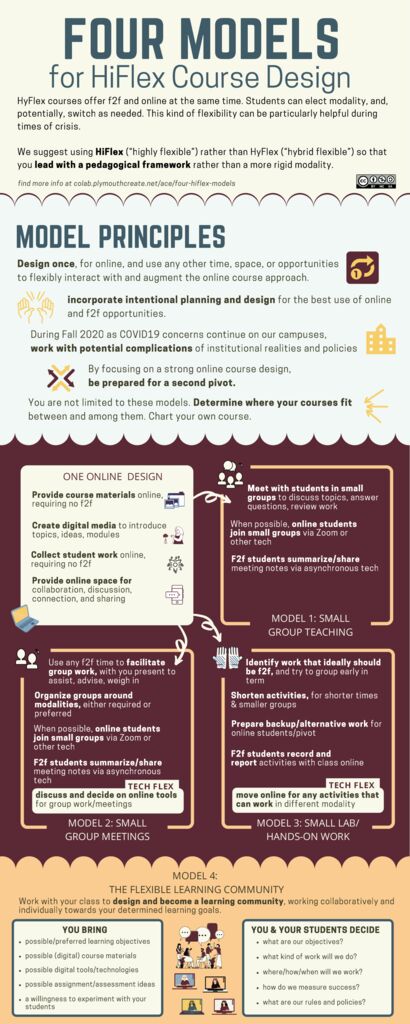When we talk about HiFlex Course Design, we are generally talking about offering a course in multiple modalities, usually for students who are physically present in the classroom and simultaneously for those who are remote/online. Development of these courses can, understandably, feel overwhelming for faculty; in fact, it can feel like every course has to be designed twice, and on any given day, faculty may have to switch modalities for specific students, depending upon whether they can be physically present.
Below, we’ve attempted to outline an alternative approach to designing HiFlex courses. Baked into our models are the following principles.
- Overall, the practice is summarized as “Design once, for online, and use any other time, space, or opportunities to flexibly interact with and augment the online course approach.”
- Every model incorporates intentional planning and design for the best use of online and f2f opportunities.
- During Fall 2020 as COVID19 concerns continue on our campuses, the determining factor about when students attend f2f may be dictated by room sizes and administrative policies; the models attempt to work within potential complications of realities and policies.
- One of the strong advantages to this approach is that if campuses find themselves having to shut down early again, by focusing on a strong online course presence (built into each model), you will already be prepared for a second pivot.
- Finally, these are NOT meant to be comprehensive. Instead, imagine these models along a continuum of opportunity. Your challenge is to determine where your courses could fit between and among the proposals.
ACE Baked In
At face value, these models clearly intersect with the ACE HiFlex Course Design practice, but it’s important to consider how all of the ACE values can infuse your design approach:
- Adaptability: consider both HiFlex and Module Course Scheduling as tools for building your own course course model. When possible, infuse them with student choice and flexibility.
- Connection: Each of these models asks you to think deliberately about what spaces, tools, and technologies you can use to create community within your course, across online and f2f interactions.
- Equity: As we prepare for Fall 2020, remember our goal to teach and reach students, regardless of barriers. Your intentional design of an online course with f2f inflections is a way to offer students the kind of access they require during complicated and complex times.


